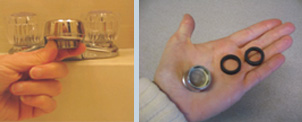To keep your faucets from leaking, preventive maintenance is the name of the game. Almost all faucets have an aerator at the tip of the faucet spout. An aerator mixes air and water for a smooth flow. You should clean aerators periodically, perhaps once a year, to remove mineral and debris buildup.

It’s easy to remove faucet aerators when you
need to do maintenance.
- Unscrew the aerator, lay aerator parts on the counter in the order in which you removed them, or make a sketch of their order, so that you put them back correctly.
- Flush the parts with water and clean the screen holes with a toothbrush or toothpick. Hard-water scale can be removed by soaking the parts in vinegar or lime dissolver.
- Flush all parts with water before putting them back together. If parts are worn, replace the worn parts or the entire aerator. Aerators are inexpensive and can be purchased at any hardware store.
Water Hammers
Ever hear a slamming or banging noise in your water pipes when someone shuts off a faucet? That sound is called a water hammer. It is caused by the sudden change of water flow, and pressure surges, which makes pipes vibrate.
Over time, recurring water hammers can loosen the mounting brackets that attach the pipes to the studs and joists in your home, leading to more movement and risk of leakage in joints and fittings. It can even cause a poorly soldered joint or fitting to completely break!
To minimize water hammers, secure pipes to prevent movement and reduce sudden pressure variations. Various devices are available that reduce the abrupt changes in water pressure.
Aerator Installation
Remove old aerator.
Inside threaded faucets:
Place upper washer (A) on lower washer (B) in top of aerator (C). Screw aerator into inside threads of faucet.
Outside threaded faucets:
Discard upper washer (A). With lower washer (B) in top of aerator, screw aerator onto outside threads.
- What to Do if Your House Smells Like Gas but There’s No Leak - February 6, 2023
- Why Is There a Burning Smell Coming From My Vents? - August 16, 2022
- How to Remove the Musty Smell From Your Air Conditioner - August 16, 2022
